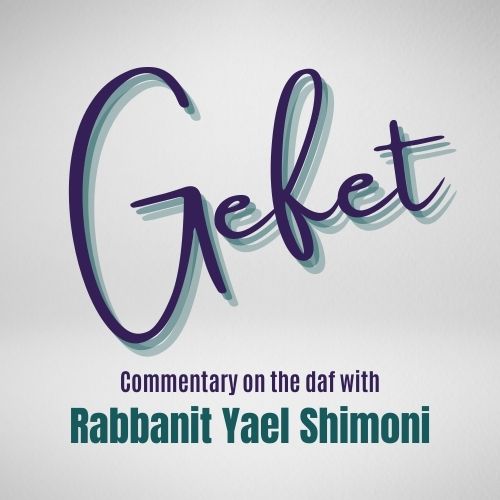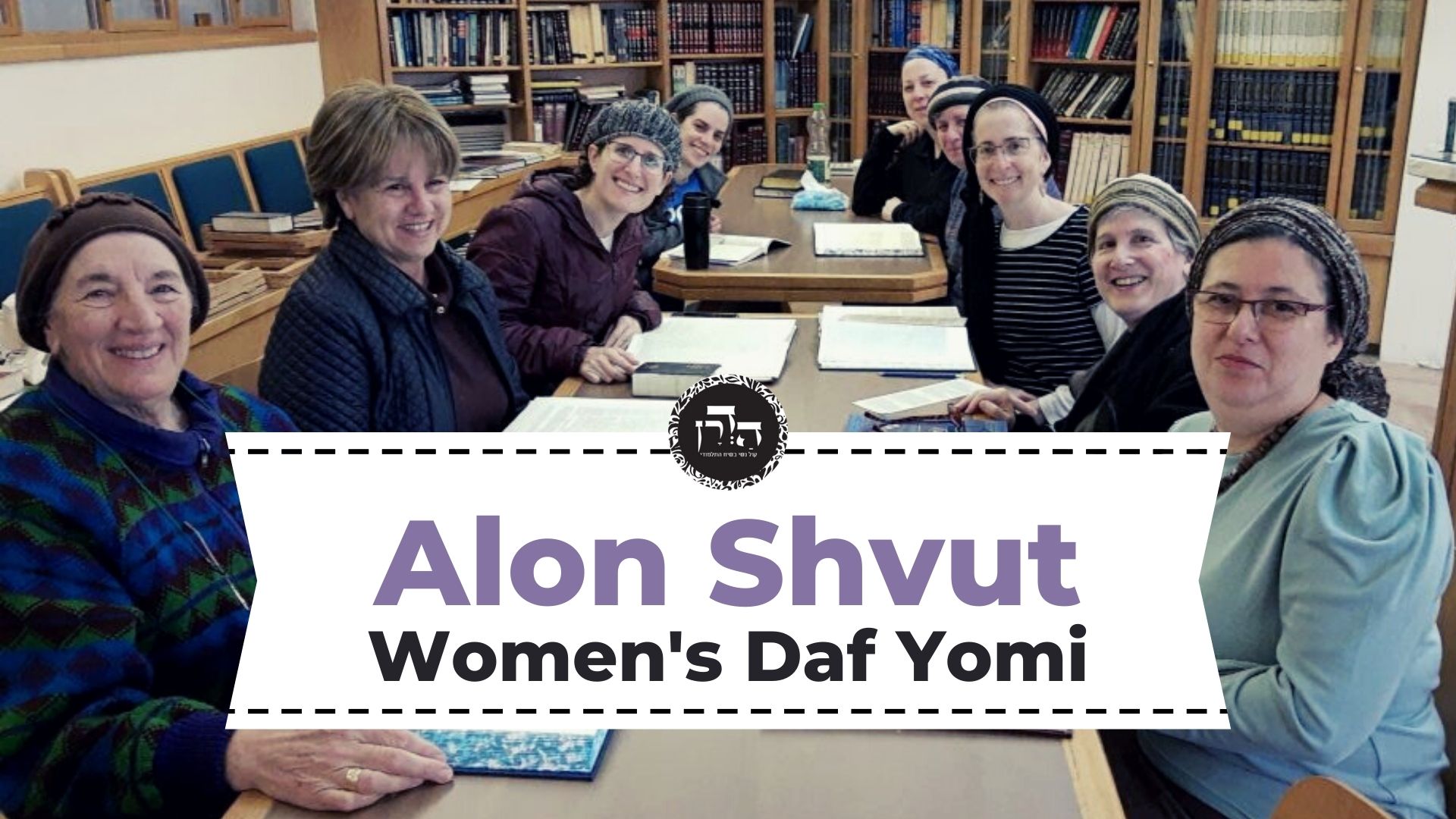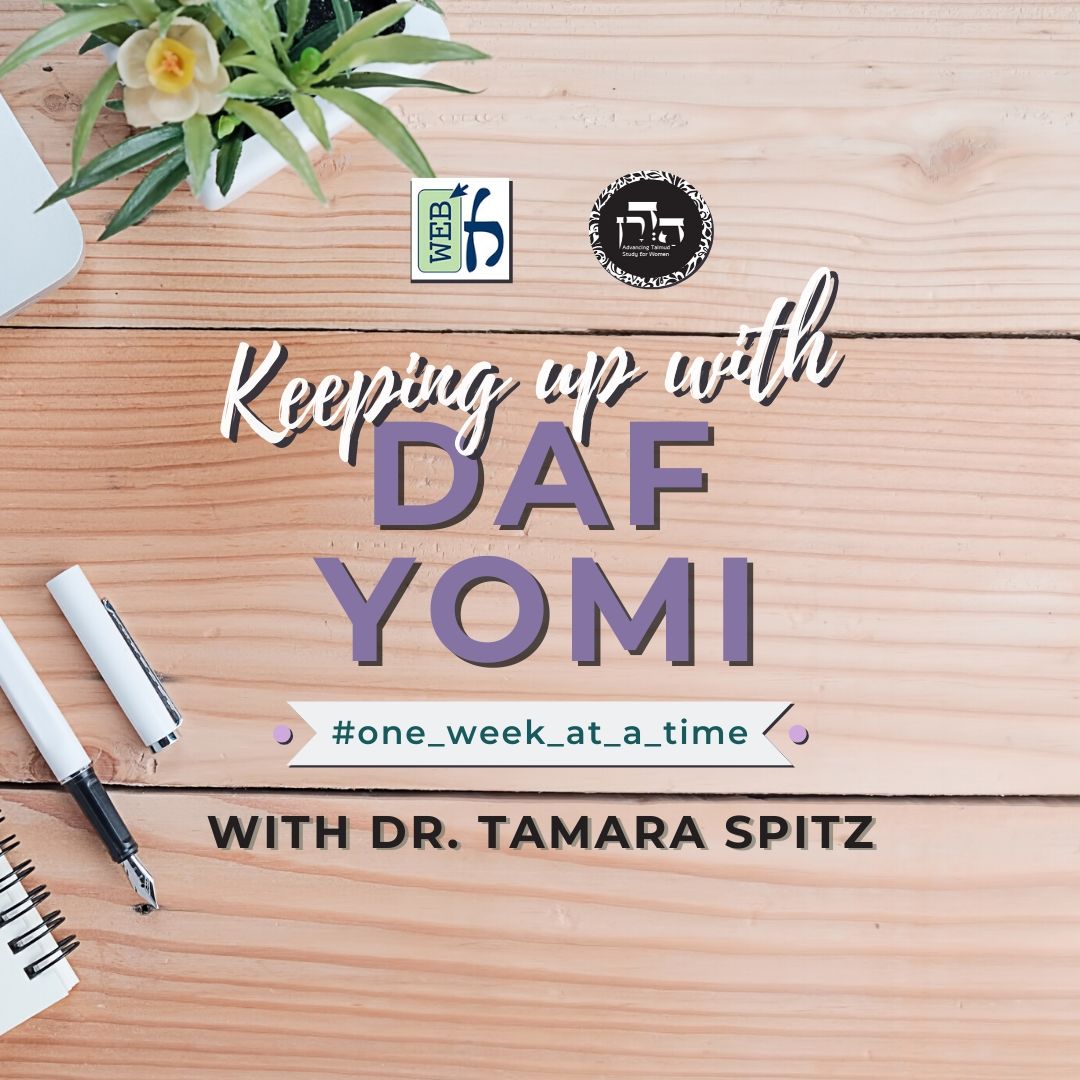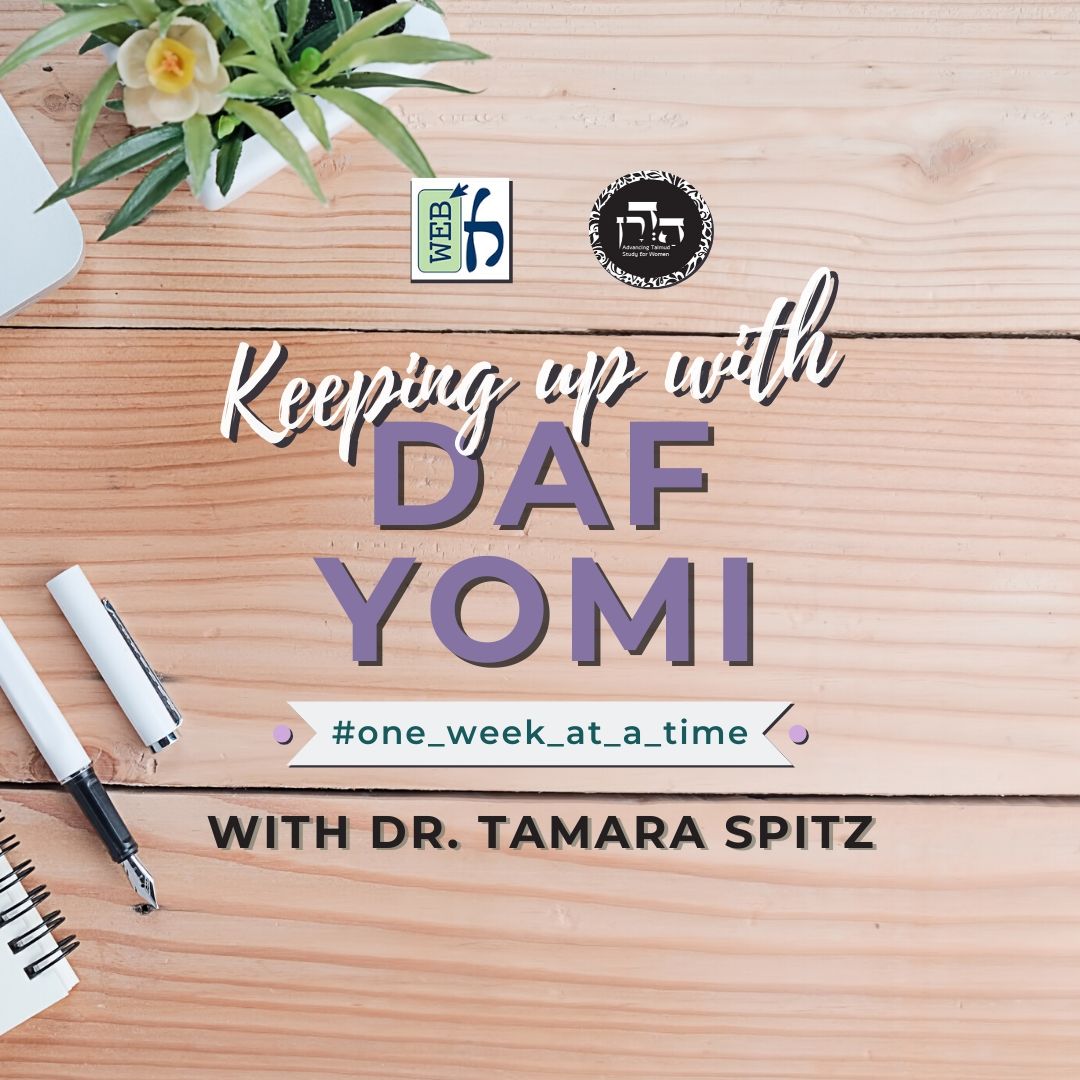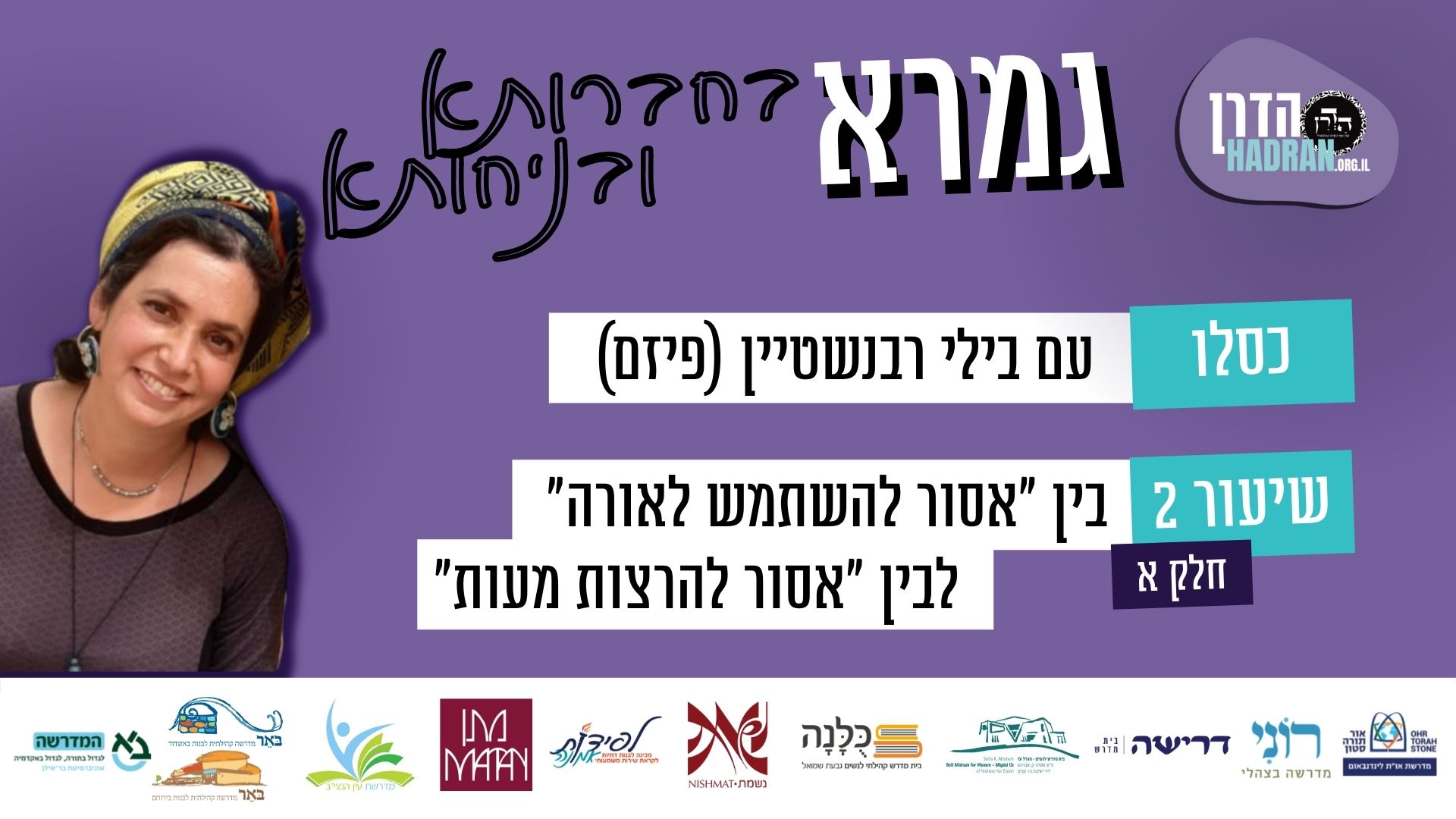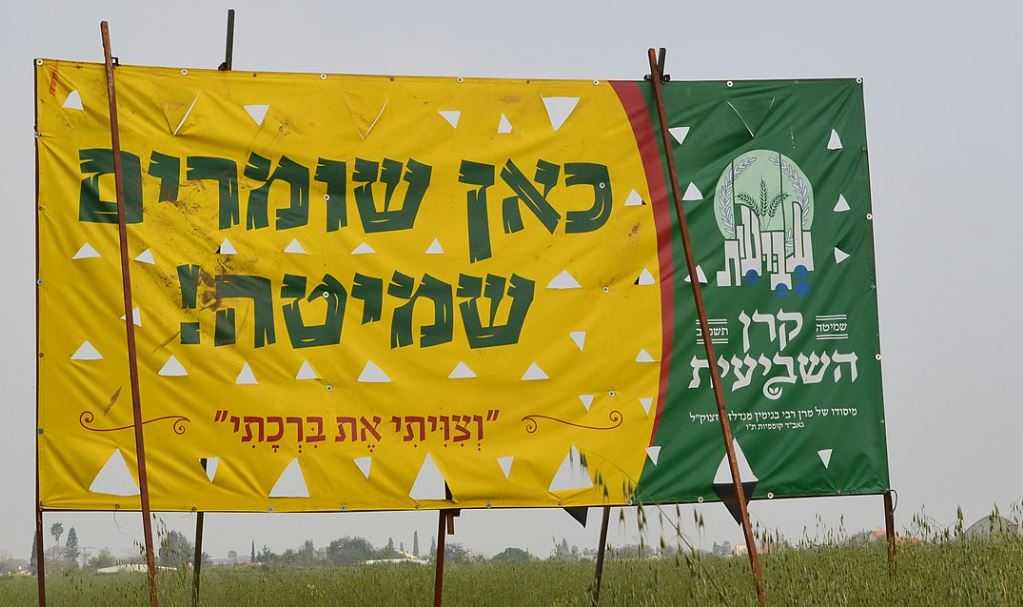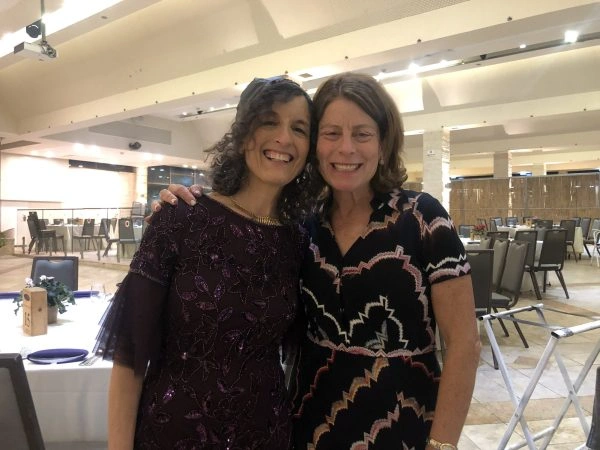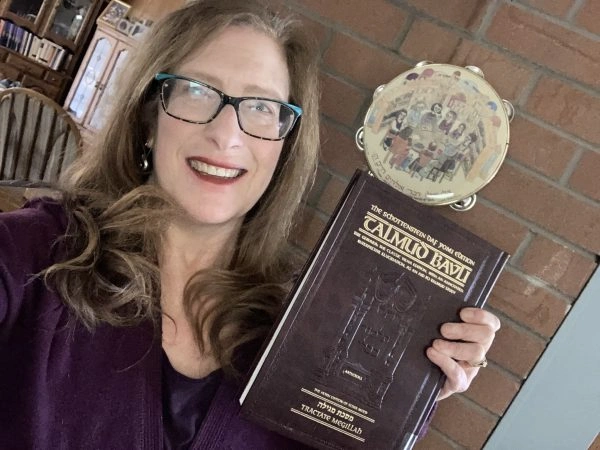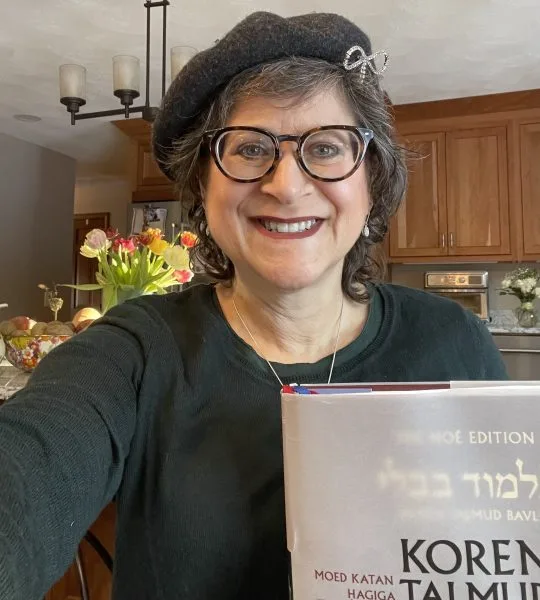How many strings? How far from the edge of the garment? How long do the strands need to hang down? Does one make a bracha on stringing the tzitzit? Can a non Jew make tzitzit? Can a woman? What part of the process needs to be done for the sake of tzitzit?
This week’s learning is sponsored by Robert and Paula Cohen in loving memory of Joseph Cohen, Yosef ben Moshe HaCohen, z”l. “He was hard working, loved to sing, esp. as a chazan, and was very dedicated to his family and community.”
Want to dedicate learning? Get started here:

Today’s daily daf tools:
This week’s learning is sponsored by Robert and Paula Cohen in loving memory of Joseph Cohen, Yosef ben Moshe HaCohen, z”l. “He was hard working, loved to sing, esp. as a chazan, and was very dedicated to his family and community.”
Today’s daily daf tools:
Delve Deeper
Broaden your understanding of the topics on this daf with classes and podcasts from top women Talmud scholars.
New to Talmud?
Check out our resources designed to help you navigate a page of Talmud – and study at the pace, level and style that fits you.
The Hadran Women’s Tapestry
Meet the diverse women learning Gemara at Hadran and hear their stories.
Menachot 42
אֵין לָהּ שִׁיעוּר לְמַעְלָה, אֲבָל יֵשׁ לָהּ שִׁיעוּר לְמַטָּה. דְּאִי לָא תֵּימָא הָכִי, כַּיּוֹצֵא בּוֹ לוּלָב אֵין לוֹ שִׁיעוּר, הָכִי נָמֵי דְּאֵין לוֹ שִׁיעוּר כְּלָל?
the baraita means that ritual fringes do not have a maximum measure, i.e., the strings can be as long as one wants; however, they do have a minimum measure, and if the strings are shorter than this measure they are not fit. As, if you do not say so, in a case similar to it, where it is taught that a lulav has no measure, is it possible that it also has no measure whatsoever?
וְהָתְנַן: לוּלָב שֶׁיֵּשׁ בּוֹ שְׁלֹשָׁה טְפָחִים כְּדֵי לְנַעְנֵעַ בּוֹ – כָּשֵׁר, אֶלָּא: אֵין לוֹ שִׁיעוּר לְמַעְלָה, אֲבָל יֵשׁ לוֹ שִׁיעוּר לְמַטָּה; הָכִי נָמֵי אֵין לוֹ שִׁיעוּר לְמַעְלָה, אֲבָל יֵשׁ לוֹ שִׁיעוּר לְמַטָּה.
But didn’t we learn in a mishna (Sukka 29b): A lulav that has three handbreadths in length, sufficient to enable one to wave with it, is fit for use in fulfilling the mitzva? This indicates that if the lulav is less than the measure, it is not fit. Rather, it must be that a lulav has no maximum measure, but it does have a minimum measure. So too, ritual fringes have no maximum measure, but they have a minimum measure.
תָּנוּ רַבָּנַן: ״צִיצִת״ – אֵין צִיצִית אֶלָּא עָנָף, וְכֵן הוּא אוֹמֵר: ״וַיִּקָּחֵנִי בְּצִיצִת רֹאשִׁי״, וְאָמַר אַבָּיֵי: וְצָרִיךְ לְפָרוֹדַהּ כִּי צוּצִיתָא דְּאַרְמָאֵי.
§ The Sages taught in a baraita: The verse states: “That they prepare for themselves strings” (Numbers 15:38). The term strings [tzitzit] means nothing other than strings that hang down [anaf], and so it states in the verse: “I was taken by a lock [betzitzit] of my head” (Ezekiel 8:3). And Abaye says: And one is required to separate the ritual fringes like a gentile’s lock of hair, part of which is braided and the rest of which is allowed to hang loose.
תָּנוּ רַבָּנַן: הֵטִיל עַל הַקֶּרֶן, אוֹ עַל הַגְּדִיל – כְּשֵׁירָה. רַבִּי אֱלִיעֶזֶר בֶּן יַעֲקֹב (אוֹמֵר) פּוֹסֵל בִּשְׁתֵּיהֶן.
The Sages taught in a baraita: If one affixed the ritual fringes to the tip of the corner or to the border [gadil], they are fit. Rabbi Eliezer ben Ya’akov disqualifies them in both cases.
כְּמַאן אָזְלָא הָא דְּאָמַר רַב גִּידֵּל אָמַר רַב: צִיצִית צְרִיכָה שֶׁתְּהֵא נוֹטֶפֶת עַל הַקֶּרֶן, שֶׁנֶּאֱמַר: ״עַל כַּנְפֵי בִגְדֵיהֶם״, כְּמַאן? כְּרַבִּי אֱלִיעֶזֶר בֶּן יַעֲקֹב.
The Gemara asks: In accordance with whose opinion is that which Rav Giddel says that Rav says: Ritual fringes must be inserted into a hole above the corner and hang down onto the corner of the garment, as it is stated: “On the corners of their garments” (Numbers 15:38)? In accordance with whose opinion is this? The Gemara answers: It is in accordance with the opinion of Rabbi Eliezer ben Ya’akov.
אָמַר רַבִּי יַעֲקֹב אָמַר רַבִּי יוֹחָנָן: וְצָרִיךְ שֶׁיַּרְחִיק מְלֹא קֶשֶׁר גּוּדָל.
Rabbi Ya’akov says that Rabbi Yoḥanan says: And one must distance the hole through which the ritual fringes are inserted into the garment the length of a full thumb joint from the edge of the garment.
וְאִיצְטְרִיךְ דְּרַב פָּפָּא, וְאִיצְטְרִיךְ דְּרַבִּי יַעֲקֹב, דְּאִי מִדְּרַב פָּפָּא הֲוָה אָמֵינָא: תּוֹךְ שָׁלֹשׁ דְּלָא לַירְחֵיק טְפֵי, וְכַמָּה דִּמְקָרַב מְעַלֵּי, אִיצְטְרִיךְ דְּרַבִּי יַעֲקֹב.
The Gemara notes: And it was necessary to state the ruling of Rav Pappa (41b) that the ritual fringes must be inserted into a hole within three fingerbreadths of the edge of the garment, and it was also necessary to state the ruling of Rabbi Ya’akov. This is because if the location of the hole was taught only from the statement of Rav Pappa, I would say that his ruling that the hole must be within three fingerbreadths of the edge of the garment was to teach that one may not distance the hole from the edge of the garment by more than this amount, but the closer the hole is to the edge of the garment, the better. Consequently, it was necessary to include the statement of Rabbi Ya’akov.
וְאִי מִדְּרַבִּי יַעֲקֹב, הֲוָה אָמֵינָא: מְלֹא קֶשֶׁר גּוּדָל, דְּלָא לִיקְרַב טְפֵי, וְכַמָּה דְּרַחִיק מְעַלֵּי, צְרִיכָא.
And if the location of the hole was taught only from the statement of Rabbi Ya’akov, I would say that his ruling that it must be a full thumb joint away from the edge of the garment was to teach that one may not situate the hole closer than that to the edge of the garment, but the further he places it, the better. Therefore, both statements were necessary.
רָבִינָא וְרַב סַמָּא הֲווֹ יָתְבִי קַמֵּיהּ דְּרַב אָשֵׁי, חַזְיֵיהּ רַב סַמָּא לְקַרְנֵיהּ דִּגְלִימֵיהּ דְּרָבִינָא דִּסְתַר וּבְצַר מִמְּלֹא קֶשֶׁר גּוּדָל, אֲמַר לֵיהּ: לָא סָבַר לַהּ מָר לְהָא דְּרַבִּי יַעֲקֹב? אֲמַר לֵיהּ: בִּשְׁעַת עֲשִׂיָּיה אִיתְּמַר.
The Gemara relates that Ravina and Rav Samma were sitting before Rav Ashi. Rav Samma saw that the corner of Ravina’s cloak was torn and therefore the hole through which the ritual fringes were inserted was less than the full length of a thumb joint from the edge of the garment. Rav Samma said to Ravina: Doesn’t the Master hold in accordance with that statement of Rabbi Ya’akov that the hole must be at least the length of a thumb joint from the edge of the garment? Ravina said to Rav Samma: It was stated that this distance is required at the time when the ritual fringes are made. If the corner tears later, causing the hole to be closer to the edge of the garment, the ritual fringes remain fit.
אִיכְּסִיף, אֲמַר לֵיהּ רַב אָשֵׁי: לָא תִּתְּקִיף לָךְ, חַד מִינַּיְיהוּ כִּתְרֵי מִינַּן.
Rav Samma became embarrassed because he had asked his question based on a mistaken assumption. Rav Ashi said to Rav Samma: Do not be upset that Ravina is a greater scholar than you are; one of them, i.e., the Sages of Eretz Yisrael, is like two of us, i.e., the Sages of Babylonia.
רַב אַחָא בַּר יַעֲקֹב רָמֵי אַרְבַּע, וְעָיֵיף לְהוּ מֵיעָף, וּמְעַיֵּיל לְהוּ בִּגְלִימָא, וְאָבֵיק לְהוּ מֵיבָק. קָסָבַר: בָּעֵינַן תְּמָנְיָא בִּגְלִימָא, כִּי הֵיכִי דְּלֶיהְוֵי ״גְּדִיל״ ״גְּדִילִים״ בִּמְקוֹם פְּתִיל.
§ With regard to attaching ritual fringes to a garment, the Gemara relates that Rav Aḥa bar Ya’akov would affix four strings to the garment, and he would first fold them in half and then insert them at the point of the folds into the hole of the garment, so that on one side there were eight strings and on the other side there were four loops. He would then take the eight strings and loop them through the four loops and pull them tight, thereby attaching them to the garment. The Gemara explains that he held that we require eight strings when they are initially placed in the garment, in order that there be twisted cord and “twisted cords” (Deuteronomy 22:12), i.e., four doubled strings, at the place, i.e., the time, when he creates the loose hanging string.
רַב יִרְמְיָה מִדִּפְתִּי רָמֵי תְּמָנְיָא, דְּאִינְהוּ שִׁיתְּסַר, וְלָא אָבֵיק לְהוּ. מָר בְּרֵיהּ דְּרָבִינָא עָבֵיד כְּדִידַן.
Rav Yirmeya of Difti would affix eight strings that are sixteen strings after they are placed in the hole of the garment and half of each string hangs down on each side, and he would not loop them as Rav Aha bar Ya’akov did. Mar, son of Ravina, would prepare ritual fringes like ours, placing four strings through the hole and allowing both ends of each string to hang down, thereby forming eight.
רַב נַחְמָן אַשְׁכְּחֵיהּ לְרַב אַדָּא בַּר אַהֲבָה רָמֵי חוּטֵי, וְקָא מְבָרֵךְ ״לַעֲשׂוֹת צִיצִית״. אֲמַר לֵיהּ: מַאי ״צִיצִי״ [דְּקָא] שָׁמַעְנָא? הָכִי אָמַר רַב: צִיצִית אֵין צְרִיכָה בְּרָכָה.
§ The Gemara relates that Rav Naḥman found Rav Adda bar Ahava affixing strings to a garment and reciting the blessing that concludes: To prepare ritual fringes [tzitzit]. Rav Naḥman said to Rav Adda bar Ahava: What is this tzitzi sound that I hear? This is what Rav says: Ritual fringes do not require a blessing when one attaches them to the garment.
כִּי נָח נַפְשֵׁיהּ דְּרַב הוּנָא, עָל רַב חִסְדָּא לְמִירְמֵא דְּרַב אַדְּרַב, וּמִי אָמַר רַב: צִיצִית אֵין צָרִיךְ בְּרָכָה? וְהָא אָמַר רַב יְהוּדָה אָמַר רַב: מִנַּיִן לְצִיצִית בְּגוֹי שֶׁהִיא פְּסוּלָה, שֶׁנֶּאֱמַר: ״דַּבֵּר אֶל בְּנֵי יִשְׂרָאֵל וְעָשׂוּ לָהֶם צִיצִת״ – בְּנֵי יִשְׂרָאֵל יַעֲשׂוּ וְלֹא הַגּוֹיִם יַעֲשׂוּ!
With regard to this statement of Rav, the Gemara relates that when Rav Huna died, Rav Ḥisda went into the study hall to raise a contradiction from one statement of Rav to another statement of Rav, as follows: Did Rav actually say that ritual fringes do not require a blessing when one attaches them to the garment? But doesn’t Rav Yehuda say that Rav says: From where is it derived that ritual fringes attached by a gentile are unfit? It is derived from a verse, as it is stated: “Speak unto the children of Israel and command them that they prepare for themselves strings” (Numbers 15:38). The Sages derive from here that the children of Israel shall prepare ritual fringes, but the gentiles shall not prepare ritual fringes.
וְהָא מַאי רוּמְיָא? אָמַר רַב יוֹסֵף: קָסָבַר רַב חִסְדָּא: כׇּל מִצְוָה שֶׁכְּשֵׁירָה בְּגוֹי – בְּיִשְׂרָאֵל אֵין צָרִיךְ לְבָרֵךְ, כׇּל מִצְוָה שֶׁפְּסוּלָה בְּגוֹי – בְּיִשְׂרָאֵל צָרִיךְ לְבָרֵךְ.
The Gemara asks: But what is the contradiction between these two statements of Rav? Rav Yosef said: Rav Ḥisda held that in the case of any mitzva for which the necessary item is fit when produced by a gentile, if it is produced by a Jew, he does not need to recite a blessing. Conversely, any mitzva for which the necessary item is unfit when produced by a gentile, if it is produced by a Jew, he needs to recite a blessing when he produces the item.
וּכְלָלָא הוּא? וַהֲרֵי מִילָה דִּכְשֵׁירָה בְּגוֹי, דְּתַנְיָא: עִיר שֶׁאֵין בָּהּ רוֹפֵא יִשְׂרָאֵל, וְיֵשׁ בָּהּ רוֹפֵא אַרְמַאי וְרוֹפֵא כּוּתִי – יָמוּל אַרְמַאי וְאַל יָמוּל כּוּתִי, דִּבְרֵי רַבִּי מֵאִיר. רַבִּי יְהוּדָה אוֹמֵר: כּוּתִי וְלֹא אַרְמַאי.
The Gemara asks: And is this an established principle? But what about circumcision, which is valid if performed by a gentile, as it is taught in a baraita: In a city in which there is no Jewish physician, and in which there is an Aramean, i.e., a gentile, physician and a Samaritan physician, it is preferable that the Aramean circumcise the Jewish boys of the city and the Samaritan not circumcise them; this is the statement of Rabbi Meir. Rabbi Yehuda says: It is preferable that the Samaritan circumcise the boys and the Aramean not circumcise them. Nevertheless, all agree that a circumcision performed by a gentile is valid.
וּבְיִשְׂרָאֵל צָרִיךְ לְבָרֵךְ, דְּאָמַר מָר: הַמָּל אוֹמֵר: ״בָּרוּךְ אֲשֶׁר קִדְּשָׁנוּ בְּמִצְוֹתָיו וְצִוָּנוּ עַל הַמִּילָה״.
And despite the fact that circumcision performed by a gentile is valid, when it is performed by a Jew, he must recite a blessing, as the Master said: The one who circumcises a child says: Blessed are You, Lord our God, King of the universe, Who has sanctified us through His mitzvot and has commanded us concerning circumcision.
מִידֵּי הוּא טַעְמָא, אֶלָּא לְרַב? רַב מִיפְסָיל פָּסֵיל, דְּאִיתְּמַר: מִנַּיִן לְמִילָה בְּגוֹי שֶׁפְּסוּלָה? דָּרוּ בַּר פָּפָּא מִשְּׁמֵיהּ דְּרַב אָמַר: ״וְאַתָּה אֶת בְּרִיתִי תִשְׁמֹר״.
The Gemara answers: Is there reason to resolve the contradiction according to anyone but Rav? Rav himself invalidates circumcision performed by a gentile, as it was stated: From where is it derived that circumcision performed by a gentile is not valid? Daru bar Pappa says in the name of Rav: This is derived from the verse: “And God said unto Abraham: And as for you, you shall keep My covenant, you, and your seed after you throughout their generations” (Genesis 17:9). The verse indicates that only the descendants of Abraham may perform circumcision.
רַבִּי יוֹחָנָן אָמַר: ״הִמּוֹל יִמּוֹל״, הַמָּל יִמּוֹל.
Rabbi Yoḥanan says that this halakha is derived from the doubled verb in the verse: “Must be circumcised [himmol yimmol]” (Genesis 17:13), which he interprets to mean: Only one who is circumcised [hammal] may circumcise [yamul] others.
סוּכָּה מְסַיַּיע לֵיהּ, תְּפִילִּין הָוֵי תְּיוּבְתֵּיהּ.
The Gemara notes that the halakha with regard to a sukka supports the opinion of Rav Ḥisda, who holds that when an item used for a mitzva can be created by a gentile, a Jew who creates it does not recite a blessing. And the halakha with regard to phylacteries is a conclusive refutation of his opinion.
הֲרֵי סוּכָּה דִּכְשֵׁירָה בְּגוֹי, דְּתַנְיָא: סוּכַּת גּוֹיִם, סוּכַּת נָשִׁים, סוּכַּת בְּהֵמָה, סוּכַּת כּוּתִיִּים, סוּכָּה מִכׇּל מָקוֹם – כְּשֵׁירָה, וּבִלְבַד שֶׁתְּהֵא מְסוּכֶּכֶת כְּהִילְכָתָהּ.
The Gemara explains: A sukka is fit even if it was built by a gentile, as it is taught in a baraita: With regard to a booth built by gentiles, a booth built by women, a booth for domesticated animals, a booth built by Samaritans, a booth of any sort, each is fit for use as a sukka, provided that it is roofed in accordance with the halakha.
וּבְיִשְׂרָאֵל אֵין צָרִיךְ לְבָרֵךְ, דְּתַנְיָא: הָעוֹשֶׂה סוּכָּה לְעַצְמוֹ אוֹמֵר: ״בָּרוּךְ אַתָּה ה׳ אֱלֹהֵינוּ מֶלֶךְ הָעוֹלָם שֶׁהֶחֱיָינוּ וְקִיְּמָנוּ וְהִגִּיעָנוּ לַזְּמַן הַזֶּה״, בָּא לֵישֵׁב בָּהּ אוֹמֵר: ״בָּרוּךְ אַתָּה ה׳ אֱלֹהֵינוּ מֶלֶךְ הָעוֹלָם אֲשֶׁר קִדְּשָׁנוּ בְּמִצְוֹתָיו וְצִוָּנוּ לֵישֵׁב בַּסּוּכָּה״, וְאִילּוּ ״לַעֲשׂוֹת סוּכָּה״ לָא מְבָרֵךְ.
And if a sukka was built by a Jew, he is not required to recite a blessing upon its construction, as it is taught in a baraita: One who constructs a sukka for himself recites: Blessed are You, Lord our God, King of the universe, Who has given us life, sustained us, and brought us to this time. When he comes to sit in the sukka, he recites: Blessed are You, Lord our God, King of the universe, Who has sanctified us through His mitzvot and commanded us to reside in the sukka. The Gemara notes that the baraita indicates that he recites a blessing at the time of construction, whereas he does not recite a blessing including the words: To construct a sukka, which confirms the opinion of Rav Ḥisda.
תְּפִילִּין תְּיוּבְתֵּיהּ, וַהֲרֵי תְּפִילִּין דִּפְסוּלוֹת בְּגוֹי, דְּתָנֵי רַב חִינָּנָא בְּרֵיהּ דְּרָבָא
By contrast, the halakha with regard to phylacteries is a conclusive refutation of Rav Ḥisda’s opinion. Phylacteries are unfit when written by a gentile, as it is taught by Rav Ḥinnana, son of Rava,
מִפַּשְׁרוּנְיָא: סֵפֶר תּוֹרָה, תְּפִילִּין וּמְזוּזוֹת שֶׁכְּתָבָן מִין, כּוּתִי, גּוֹי, עֶבֶד, אִשָּׁה, וְקָטָן, וְיִשְׂרָאֵל מְשׁוּמָּד – פְּסוּלִין, שֶׁנֶּאֱמַר: ״וּקְשַׁרְתָּם״ ״וּכְתַבְתָּם״, כֹּל שֶׁיֶּשְׁנוֹ בִּקְשִׁירָה יֶשְׁנוֹ בִּכְתִיבָה, כֹּל שֶׁאֵינוֹ בִּקְשִׁירָה אֵינוֹ בִּכְתִיבָה.
of Pashronya: A Torah scroll, phylacteries, or mezuzot that were written by a heretic, a Samaritan, a gentile, a Canaanite slave, a woman, a minor, or a Jewish apostate [meshummad] are unfit, as it is stated: “And you shall bind them for a sign on your arm…and you shall write them on the doorposts of your house” (Deuteronomy 6:8–9). From this juxtaposition, one can derive the following: Anyone who is included in the mitzva of binding the phylacteries, i.e., one who is both obligated and performs the mitzva, is included in the class of people who may write Torah scrolls, phylacteries, and mezuzot; and anyone who is not included in the mitzva of binding is not included in the class of people who may write sacred texts.
וּבְיִשְׂרָאֵל אֵין צָרִיךְ לְבָרֵךְ, דִּשְׁלַח רַב חִיָּיא בְּרֵיהּ דְּרַב הוּנָא מִשְּׁמֵיהּ דְּרַבִּי יוֹחָנָן: עַל תְּפִילִּין שֶׁל יָד אוֹמֵר: ״בָּרוּךְ אֲשֶׁר קִדְּשָׁנוּ בְּמִצְוֹתָיו וְצִוָּנוּ לְהַנִּיחַ תְּפִילִּין״, עַל תְּפִילִּין שֶׁל רֹאשׁ אוֹמֵר: ״בָּרוּךְ אֲשֶׁר קִדְּשָׁנוּ בְּמִצְוֹתָיו וְצִוָּנוּ עַל מִצְוַת תְּפִילִּין״, וְאִילּוּ ״לַעֲשׂוֹת תְּפִילִּין״ לָא מְבָרֵךְ!
And despite the fact that phylacteries written by a gentile are unfit, a Jew who writes them does not have to recite a blessing. As Rav Ḥiyya, son of Rav Huna, sent a ruling in the name of Rabbi Yoḥanan: On phylacteries of the arm one says the blessing: Blessed are You, Lord our God, King of the universe, Who has sanctified us through His mitzvot and commanded us to don phylacteries. On phylacteries of the head one says the blessing: Blessed are You, Lord our God, King of the universe, Who has sanctified us through His mitzvot and commanded us concerning the mitzva of phylacteries. The implication of this is that one recites blessings only when he dons the phylacteries, whereas when he writes the phylacteries he does not recite a blessing: To prepare phylacteries.
אֶלָּא לָאו הַיְינוּ טַעְמָא: כׇּל מִצְוָה דַּעֲשִׂיָּיתָהּ גְּמַר מִצְוָה, כְּגוֹן מִילָה, אַף עַל גַּב דִּכְשֵׁירָה בְּגוֹי – בְּיִשְׂרָאֵל צָרִיךְ לְבָרֵךְ, וְכׇל מִצְוָה דַּעֲשִׂיָּיתָהּ לָאו גְּמַר מִצְוָה, כְּגוֹן תְּפִילִּין, אַף עַל גַּב דִּפְסוּלוֹת בְּגוֹי – בְּיִשְׂרָאֵל אֵינוֹ צָרִיךְ לְבָרֵךְ.
Rather, isn’t this the reason for the distinction between different mitzvot: For any mitzva whose performance is the completion of the mitzva, such as circumcision, even though it is valid when performed by a gentile, when it is performed by a Jew he must recite a blessing. But for any mitzva where the performance of a particular act is not the completion of the mitzva, such as writing phylacteries, where one does not complete the mitzva until he dons them, even though it is not valid when performed by a gentile, when it is performed by a Jew he does not need to recite a blessing.
וּבְצִיצִית, בְּהָא קָמִיפַּלְגִי: מָר סָבַר חוֹבַת טַלִּית הוּא, וּמָר סָבַר חוֹבַת גַּבְרָא הוּא.
And with regard to reciting a blessing when one attaches ritual fringes to a garment, the Sages disagree about this: One Sage, Rav Adda bar Ahava, holds that it is an obligation pertaining to the cloak. Therefore, when one attaches the ritual fringes he is completing the mitzva, and he should recite a blessing: To prepare ritual fringes. And one Sage, Rav Naḥman, citing Rav, holds that it is an obligation incumbent upon the man. Consequently, the mitzva is not complete until he wears the garment, and he should not recite a blessing when he attaches the ritual fringes to the garment.
אֲמַר לֵיהּ רַב מָרְדֳּכַי לְרַב אָשֵׁי: אַתּוּן הָכִי מַתְנִיתוּ לַהּ.
Rav Mordekhai said to Rav Ashi: You teach this halakha about gentiles attaching ritual fringes to a garment in this manner, citing Rav Yehuda in the name of Rav that the ritual fringes are invalid. Consequently, Rav Ḥisda raises a contradiction between this ruling and another ruling of Rav.
אֲנַן הָכִי מַתְנֵינַן לַהּ, אָמַר רַב יְהוּדָה אָמַר רַב: מִנַּיִן לְצִיצִית בְּגוֹי שֶׁכְּשֵׁירָה? שֶׁנֶּאֱמַר: ״דַּבֵּר אֶל בְּנֵי יִשְׂרָאֵל וְעָשׂוּ לָהֶם צִיצִית״, יַעֲשׂוּ לָהֶם אֲחֵרִים.
We teach it in this way, according to which there is no contradiction: Rav Yehuda says that Rav says: From where is it derived that if ritual fringes are attached to a garment by a gentile they are valid? It is derived from that which is stated: “Speak unto the children of Israel and command them that they prepare for themselves [lahem] strings” (Numbers 15:38). From the fact that the verse does not merely state: That they prepare [ve’asu], but rather states “ve’asu lahem,” which can be translated as: That they prepare for them, the indication is that even others, i.e., gentiles, shall prepare ritual fringes for them.
אָמַר רַב יְהוּדָה אָמַר רַב: עֲשָׂאָן מִן הַקּוֹצִים, וּמִן הַנִּימִין, וּמִן הַגְּרָדִין – פְּסוּלָה, מִן הַסִּיסִין – כְּשֵׁירָה.
§ Rav Yehuda says that Rav says: If one prepared ritual fringes from threads that protrude from the fabric like thorns [kotzim], or if he prepared them from threads [nimin] that were used to sew the garment and remain attached to it, or from the strings [geradin] that hang from the bottom of a garment, the ritual fringes are unfit, as one must attach ritual fringes to a garment for the sake of the mitzva. But if he prepared ritual fringes from swatches of wool that were not spun for the sake of the mitzva, they are fit.
כִּי אַמְרִיתַהּ קַמֵּיהּ דִּשְׁמוּאֵל, אָמַר: אַף מִן הַסִּיסִין פְּסוּלָה, בָּעֵינַן טְוִיָּיה לִשְׁמָהּ.
Rav Yehuda continues: When I stated this halakha in the name of Rav before Shmuel, he said to me: Even ritual fringes tied from swatches of wool that were not spun for the sake of the mitzva are unfit, as we require the spinning of the string to be for the sake of the mitzva.
כְּתַנָּאֵי: צִיפָּן זָהָב, אוֹ שֶׁטָּלָה עֲלֵיהֶן עוֹר בְּהֵמָה טְמֵאָה – פְּסוּלוֹת. עוֹר בְּהֵמָה טְהוֹרָה – כְּשֵׁירוֹת, וְאַף עַל פִּי שֶׁלֹּא עִיבְּדָן לִשְׁמָן. רַבָּן שִׁמְעוֹן בֶּן גַּמְלִיאֵל אוֹמֵר: אַף עוֹר בְּהֵמָה טְהוֹרָה פְּסוּלוֹת, עַד שֶׁיְּעַבְּדֵן לִשְׁמָן.
The Gemara notes that this dispute is like a dispute between tanna’im, as it is taught in a baraita: If one took phylacteries and coated them with gold or patched them with the skin of a non-kosher animal, then they are unfit. But if one patched them with the skin of a kosher animal, then they are fit, and this is so even though he did not prepare the skin for their sake, i.e., for the sake of its use in a mitzva. Rabban Shimon ben Gamliel says: Even if he patched them with the skin of a kosher animal they are unfit, until he prepares them for their sake.
אֲמַר לֵיהּ אַבָּיֵי לְרַב שְׁמוּאֵל בַּר רַב יְהוּדָה: הָא תְּכֵילְתָּא הֵיכִי צָבְעִיתוּ לַהּ? אֲמַר לֵיהּ: מַיְיתִינַן דַּם חִלָּזוֹן וְסַמָּנִין, וְרָמֵינַן לְהוּ בְּיוֹרָה, וְשָׁקְלִינַן פּוּרְתָּא בְּבֵיעֲתָא, וְטָעֲמִינַן לְהוּ בְּאוּדְרָא, וְשָׁדֵינַן לַיהּ לְהָהוּא בֵּיעֲתָא, וְקָלֵינַן לֵיהּ לְאוּדְרָא.
§ Abaye said to Rav Shmuel bar Rav Yehuda: How do you dye this sky-blue wool to be used for ritual fringes? Rav Shmuel bar Rav Yehuda said to Abaye: We bring blood of a ḥilazon and various herbs and put them in a pot and boil them. And then we take a bit of the resulting dye in an egg shell and test it by using it to dye a wad of wool to see if it has attained the desired hue. And then we throw away that egg shell and its contents and burn the wad of wool.
שְׁמַע מִינַּהּ תְּלָת: שְׁמַע מִינַּהּ טְעִימָה פְּסוּלָה, וּשְׁמַע מִינַּהּ דְּבָעֵינַן צְבִיעָה לִשְׁמָהּ, וּשְׁמַע מִינַּהּ טְעִימָה פָּסְלָה.
The Gemara comments: Learn from this statement three halakhot: Learn from it that wool that was dyed for the purpose of testing the dye and not for use as ritual fringes is unfit for ritual fringes. Consequently, one burns the wad of wool so that no one will use it for ritual fringes. And learn from it that we require dyeing for the sake of the mitzva. And learn from it that using dye for testing renders all the dye in that vessel unfit. Therefore, some of the dye is removed from the pot before it is tested.
הַיְינוּ טְעִימָה פְּסוּלָה, הַיְינוּ צְבִיעָה לִשְׁמָהּ? אָמַר רַב אָשֵׁי: מָה טַעַם קָאָמַר – מָה טַעַם טְעִימָה פְּסוּלָה? מִשּׁוּם דְּבָעֵינַן צְבִיעָה לִשְׁמָהּ.
The Gemara challenges: The halakha that wool dyed for the purpose of testing the dye is unfit is the same as the requirement of dyeing for the sake of the mitzva. It is only because the sky-blue strings must be dyed for the sake of the mitzva that wool dyed as a test is unfit for use as ritual fringes, so why are these stated as two halakhot? Rav Ashi said: The statement about learning three halakhot employs the style known as: What is the reason, and it means: What is the reason that wool that was dyed for the purpose of testing is unfit? It is because we require dyeing for the sake of the mitzva.
כְּתַנָּאֵי: טְעִימָה פְּסוּלָה, מִשּׁוּם שֶׁנֶּאֱמַר: ״כְּלִיל תְּכֵלֶת״, דִּבְרֵי רַבִּי חֲנִינָא בֶּן גַּמְלִיאֵל.
The Gemara notes that the halakha that using the dye for testing renders all the dye in the pot unfit is subject to a dispute between tanna’im, as it is taught in a baraita: Tekhelet dye that was used for testing is unfit, as it is stated concerning the priestly vestments: “And you shall make the robe of the ephod entirely of blue [kelil tekhelet]” (Exodus 28:31), which indicates that the dye must be used exclusively for this purpose, i.e., this must be the first item it is being used to dye. This is the statement of Rabbi Ḥanina ben Gamliel.
רַבִּי יוֹחָנָן בֶּן דַּהֲבַאי אוֹמֵר: אֲפִילּוּ מַרְאֶה שֵׁנִי שֶׁבָּהּ כָּשֵׁר, מִשּׁוּם שֶׁנֶּאֱמַר: ״וּשְׁנִי תוֹלָעַת״.
Rabbi Yoḥanan ben Dahavai says: Even a second appearance caused by the dye is fit, meaning even if it is the second time that the dye is being used, it is still fit. As it is stated in the verse: “And scarlet wool [ushni tola’at]” (Leviticus 14:4), which is interpreted to mean that this may be the second [sheni] usage of the dye.
תָּנוּ רַבָּנַן: תְּכֵלֶת אֵין לָהּ בְּדִיקָה, וְאֵין נִיקַּחַת אֶלָּא מִן הַמּוּמְחֶה. תְּפִילִּין יֵשׁ לָהֶם בְּדִיקָה, וְאֵין נִיקָּחִין אֶלָּא מִן הַמּוּמְחֶה. סְפָרִים וּמְזוּזוֹת יֵשׁ לָהֶן בְּדִיקָה, וְנִיקָּחִין מִכׇּל אָדָם.
The Sages taught in a baraita: There is no reliable method of testing sky-blue wool, and therefore it may be purchased only from an expert. There is a method of testing phylacteries to ensure they were written properly, but nevertheless they may be purchased only from an expert. There is a method of testing Torah scrolls and mezuzot, and they may be purchased from anyone.
וּתְכֵלֶת אֵין לָהּ בְּדִיקָה? וְהָא רַב יִצְחָק בְּרֵיהּ דְּרַב יְהוּדָה בָּדֵיק לֵיהּ! (סִימָן בְּגֶשֶׁם) מַיְיתֵי מַגְבְּיָא גִּילָא, וּמַיָּא דְּשַׁבְלִילְתָּא, וּמֵימֵי רַגְלַיִם
The Gemara asks: And is there no method for testing sky-blue wool? But didn’t Rav Yitzḥak, son of Rav Yehuda, test it to ensure it was dyed with tekhelet? The Gemara provides a mnemonic for the test, which was carried out with items whose names contain the letters gimmel, shin, or mem. He would bring alum clay [megavya gila], and water of fenugreek [shavlilta], and urine [meimei raglayim]


